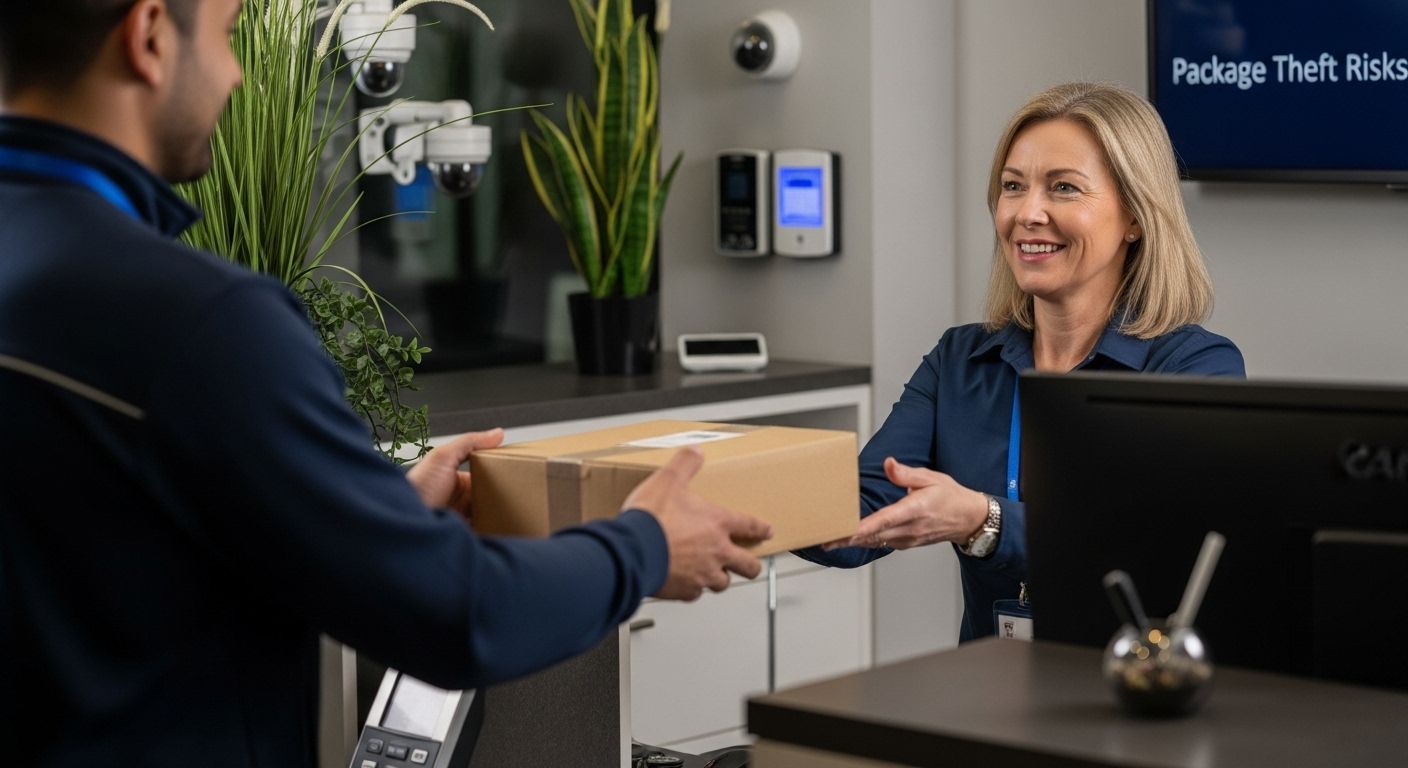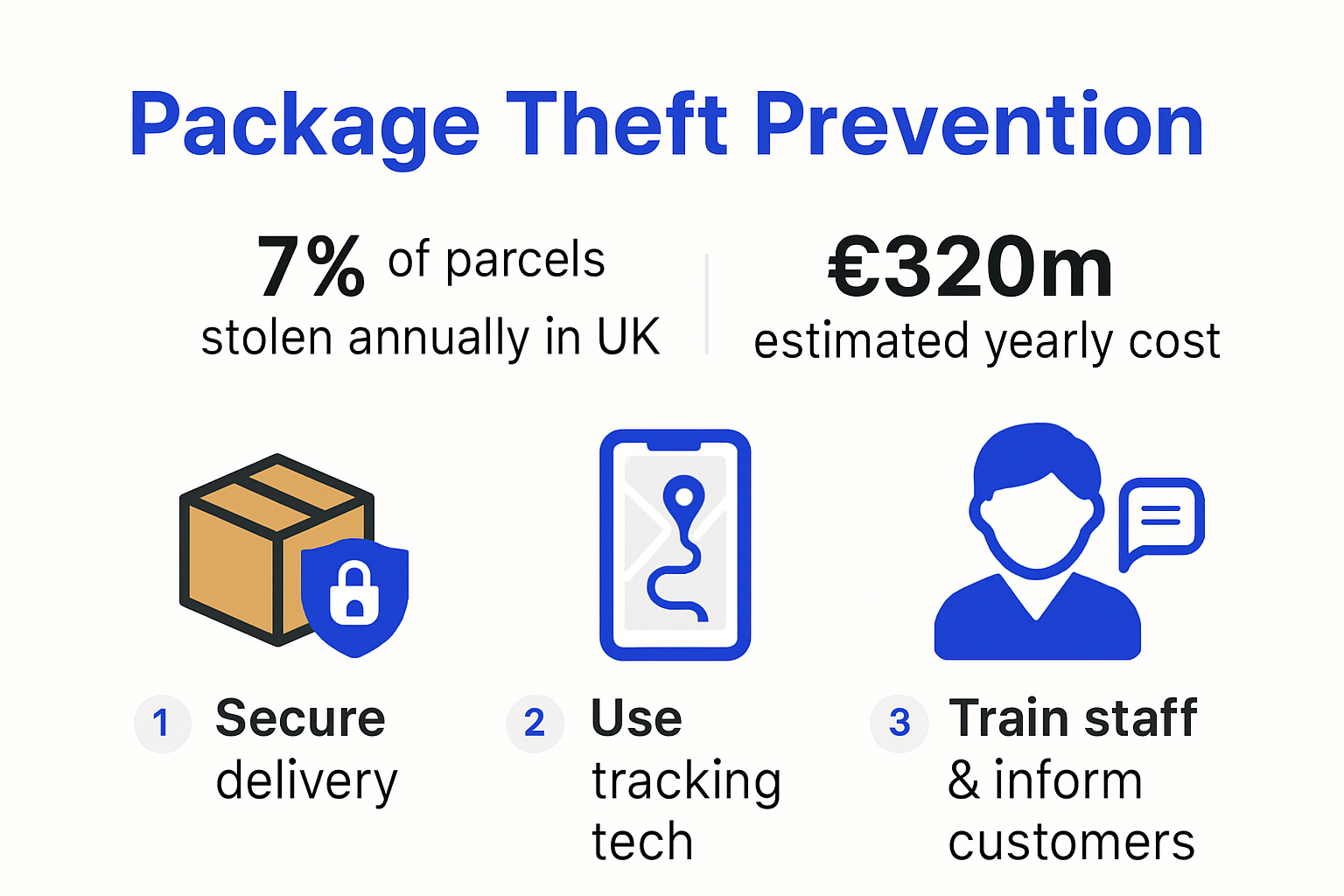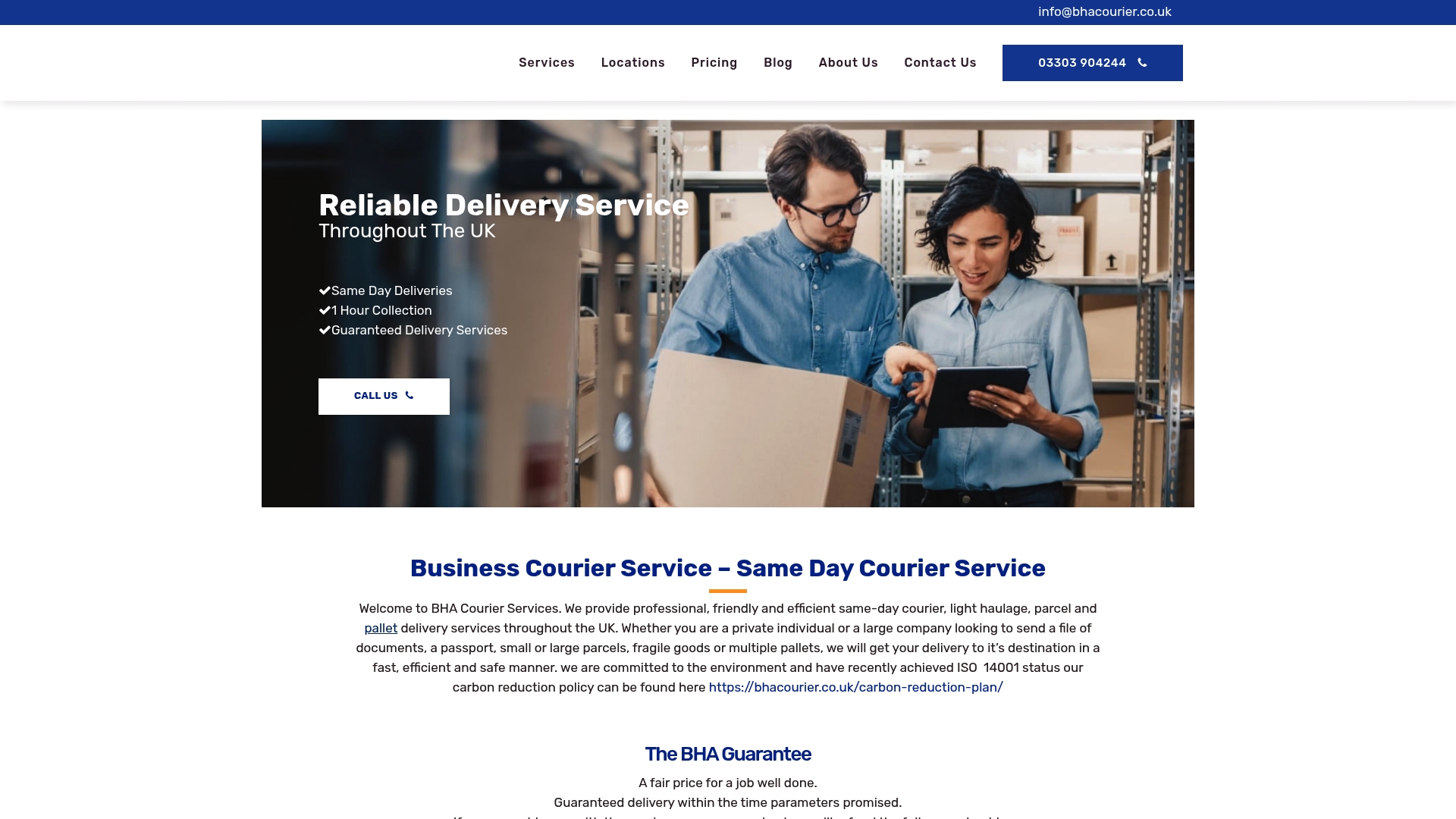
15 Aug Essential Package Theft Prevention Strategies for UK Businesses
Package theft is becoming a serious threat for UK businesses, with an estimated 8% of all parcels going missing or stolen in some areas. Most firms ramp up their security after a very public loss or customer complaint, convinced it is a one-off. Yet the real risk is far more widespread and quietly drains profits across every sector. Smart prevention is no longer optional—it is the difference between protecting your reputation and facing ongoing losses few ever see coming.
Table of Contents
- Understanding Package Theft Risks In The UK
- Practical Steps For Package Theft Prevention
- Innovative Technologies For Securing Deliveries
- Best Policies For E-Commerce And Business Owners
Quick Summary
| Takeaway | Explanation |
|---|---|
| Implement secure delivery locations | Use designated areas with access control and CCTV to reduce theft risks. |
| Utilise advanced tracking technologies | Invest in GPS tracking and real-time notifications for monitored deliveries. |
| Provide extensive employee training | Equip staff with security knowledge to identify and respond to theft attempts. |
| Adopt discreet packaging methods | Use neutral packaging and minimal external labelling to deter potential thieves. |
| Foster transparent customer communication | Keep customers informed about delivery status and security measures for peace of mind. |

Understanding Package Theft Risks in the UK
Package theft has become a growing concern for businesses across the United Kingdom, transforming from an occasional inconvenience to a significant operational challenge. Insights into delivery security risks from the Office for National Statistics reveal a troubling trend in parcel-related criminal activities that demand immediate attention from business owners.
The Scale of Package Theft in Modern Commerce
The exponential growth of e-commerce has inadvertently created numerous opportunities for package theft. According to research from The Conversation, the surge in online shopping during and after the COVID-19 pandemic has significantly amplified the risks for businesses and consumers alike. Criminals have become increasingly sophisticated in targeting unattended deliveries, with residential and commercial locations equally vulnerable.
Understanding the specific dynamics of package theft requires examining multiple factors. Opportunistic thieves often target packages left in easily accessible areas, exploiting brief windows of vulnerability during delivery and collection processes. This risk is particularly acute for businesses without robust security protocols or those relying on standard delivery methods that do not prioritize package protection.
Economic and Operational Implications
The financial impact of package theft extends far beyond the immediate value of stolen goods. Businesses face substantial indirect costs including replacement expenses, customer compensation, reputational damage, and potential loss of future business. Each stolen package represents not just a monetary loss, but a breach of customer trust that can have long-lasting consequences.
Moreover, the administrative burden of managing theft-related incidents consumes valuable resources. Staff time spent investigating missing packages, processing insurance claims, and managing customer communications can significantly disrupt normal business operations. Small and medium-sized enterprises are especially vulnerable, as they often lack dedicated logistics security teams.
Our comprehensive guide on secure delivery strategies provides businesses with practical insights into mitigating these risks. By understanding the landscape of package theft, organisations can develop proactive strategies that protect their assets, maintain customer confidence, and minimise potential financial losses.
The complexity of package theft prevention demands a multifaceted approach. Businesses must combine technological solutions, strategic delivery planning, and continuous staff training to create a comprehensive security ecosystem that deters potential thieves and safeguards valuable shipments.
Practical Steps for Package Theft Prevention
Navigating the complex landscape of package theft requires businesses to implement strategic and comprehensive prevention measures. Insights from delivery security experts highlight the critical importance of proactive security protocols in protecting valuable shipments.
Strategic Delivery Location Management
Selecting secure delivery locations is paramount in preventing package theft. Businesses must move beyond traditional delivery approaches and adopt more sophisticated strategies. The American Gem Society recommends several key tactics to minimise theft risks. These include using discreet external packaging that does not reveal the contents or value of the package, limiting information shared during delivery communications, and avoiding vulnerable drop-off locations.
Key strategies for secure delivery locations include:
- Designated Secure Reception Areas: Establishing dedicated spaces within business premises specifically designed for receiving and storing packages.
- Access-Controlled Delivery Zones: Implementing restricted entry points with security personnel or electronic access systems.
- Video Surveillance: Installing comprehensive CCTV systems to monitor delivery and collection zones.
Technology and Tracking Solutions
Modern technology offers robust solutions for package theft prevention. Advanced tracking systems and digital monitoring tools provide businesses with real-time insights into package movements. According to United States Postal Service research, implementing comprehensive tracking mechanisms can significantly reduce the likelihood of theft.
Our secure shipping guide provides comprehensive strategies for leveraging technology in package protection. Businesses should consider investing in:
- GPS-enabled tracking devices
- Real-time notification systems
- Tamper-evident packaging
- Digital signature confirmation technologies
Employee Training and Awareness
Human factors play a crucial role in package theft prevention. Comprehensive staff training programmes can transform employees into active participants in security protocols. This involves educating team members about potential risks, teaching them to recognise suspicious activities, and establishing clear procedures for package handling and reporting.
Effective training should cover:
- Recognising potential security vulnerabilities
- Proper package handling and storage techniques
- Reporting mechanisms for suspected theft attempts
- Understanding the financial and reputational implications of package loss
By adopting a holistic approach that combines technological solutions, strategic planning, and human expertise, businesses can create a robust defence against package theft. Continuous evaluation and adaptation of these strategies will be key to staying ahead of evolving criminal tactics.
To help readers quickly compare various package theft prevention measures, the following table summarises key practical strategies mentioned in the article, detailing their purpose and benefits.
| Prevention Measure | Purpose | Benefits |
|---|---|---|
| Secure Delivery Locations | Control where packages are received | Minimises risk of unauthorised access |
| Access-Controlled Delivery Zones | Restrict entry to delivery areas | Deters unauthorised personnel |
| Video Surveillance (CCTV) | Monitor and record package handling | Enables evidence collection, deterrence |
| GPS-enabled Tracking Devices | Track package location in real-time | Enables prompt response to theft/loss |
| Tamper-Evident Packaging | Indicates if package has been compromised | Discourages interference, increases trust |
| Employee Security Training | Educate staff on security protocols | Reduces human error, improves vigilance |
| Real-Time Notifications | Inform stakeholders about delivery progress | Faster response to potential theft |
Innovative Technologies for Securing Deliveries
The rapidly evolving landscape of delivery security demands cutting-edge technological solutions that go beyond traditional protection methods. Advanced research in logistics technology reveals groundbreaking approaches to safeguarding packages throughout their journey.
Intelligent Tracking and Authentication Systems
Cutting-edge authentication technologies are revolutionising package security. Researchers have developed sophisticated multi-factor authentication protocols specifically designed for automated delivery systems. These innovative approaches address critical security challenges by implementing complex verification mechanisms that significantly reduce the risk of theft and impersonation.
Key technological innovations include:
- Biometric Verification: Advanced systems using facial recognition and fingerprint scanning
- QR Code Tracking: Dynamic tracking mechanisms that provide real-time package location updates
- Cryptographic Authentication: Encrypted digital signatures ensuring package integrity
Smart Video Detection Technologies
Artificial intelligence is transforming package security through advanced video monitoring technologies. Cutting-edge research has developed frameworks capable of generating package theft detection scores with remarkable 80% accuracy. These intelligent systems can:
- Automatically identify suspicious activities
- Generate real-time alerts for potential theft attempts
- Provide comprehensive video analysis for security investigations
Our comprehensive logistics technology guide offers deeper insights into these emerging security technologies, helping businesses stay ahead of potential threats.
Robotic and Automated Delivery Solutions
The future of secure deliveries lies in automated technologies that minimise human intervention. Robotic delivery systems equipped with advanced tracking and security features represent a significant leap forward in package protection. These technologies offer:
- Reduced human error
- Enhanced tracking capabilities
- Improved overall delivery security
- Minimised potential for external theft attempts
Businesses that embrace these innovative technologies will position themselves at the forefront of delivery security. The integration of artificial intelligence, advanced authentication protocols, and intelligent monitoring systems creates a comprehensive approach to protecting valuable shipments.
This table outlines the key advantages and functions of innovative technologies described in the article for improving delivery security. It provides a quick overview to aid decision-making on which technologies to adopt.
| Technology Type | Key Features | Main Advantages |
|---|---|---|
| Biometric Verification | Facial recognition, fingerprint scanning | Enhanced authentication, reduced theft risk |
| QR Code Tracking | Real-time tracking via dynamic QR codes | Visibility throughout delivery process |
| Cryptographic Authentication | Encrypted digital signatures | Ensures package integrity |
| AI Video Detection | Detects suspicious activities, theft alerts | Automated monitoring, quick response |
| Robotic Delivery Systems | Automated, tracked and minimised human involvement | Reduced human error, increased security |
As criminal methods become increasingly sophisticated, technological solutions must continuously evolve. By investing in these cutting-edge technologies, businesses can significantly reduce package theft risks and provide customers with unprecedented levels of delivery security.
Best Policies for E-commerce and Business Owners
E-commerce businesses face increasingly complex challenges in protecting packages from theft, requiring comprehensive and strategic policy implementation. Insights from postal security experts underscore the critical need for proactive and adaptive approaches to delivery security.
Packaging and Information Management Strategies
Secure packaging represents the first line of defence against potential theft. The American Gem Society recommends adopting strategies that minimise the attractiveness of packages to potential criminals. This involves creating discreet external packaging that does not reveal the contents or value of the shipment.
Key packaging policies should include:

- Neutral Packaging Design: Using plain, unmarked packaging that does not indicate valuable contents
- Minimal External Labelling: Reducing visible information that could attract unwanted attention
- Tamper-Evident Sealing: Implementing packaging solutions that show clear signs of interference
Delivery Location and Authentication Protocols
Managing delivery locations is crucial in preventing package theft. Massachusetts government guidelines provide comprehensive recommendations for secure delivery practices. Businesses must develop robust protocols that prioritise package security throughout the delivery process.
Effective delivery policies should encompass:
- Requiring signature confirmations for high-value items
- Offering secure alternative delivery locations
- Implementing real-time tracking and customer notification systems
Our small business shipping guide offers detailed strategies for optimising delivery security and minimising theft risks.
Customer Communication and Risk Mitigation
Transparent and proactive communication with customers is essential in creating a comprehensive package theft prevention strategy. Businesses should educate customers about potential risks and provide practical guidance for secure package receipt.
Recommended communication approaches include:
- Providing detailed delivery tracking information
- Offering flexible delivery time windows
- Advising customers on best practices for package security
- Establishing clear protocols for managing lost or stolen packages
Successful package theft prevention requires a holistic approach that combines technological solutions, strategic policies, and ongoing customer engagement. By implementing these comprehensive strategies, e-commerce businesses can significantly reduce the risk of package theft and build trust with their customers.
Businesses must remain adaptable, continuously reviewing and updating their policies to address emerging security challenges. Investing in robust prevention strategies not only protects valuable shipments but also demonstrates a commitment to customer satisfaction and operational excellence.
Frequently Asked Questions
What are the most effective strategies to prevent package theft for UK businesses?
Implementing secure delivery locations, utilising advanced tracking technologies, providing employee training, and adopting discreet packaging methods are key strategies to prevent package theft.
How can technology help businesses secure their packages?
Technology aids in secure package delivery through GPS tracking, real-time notifications, tamper-evident packaging, and advanced video monitoring systems, which collectively enhance visibility and security throughout the delivery process.
Why is employee training important in preventing package theft?
Employee training equips staff with the skills to identify suspicious activities, enforce security protocols, and effectively respond to theft attempts, thereby reducing the risk of theft through human error.
How can businesses effectively communicate security measures to customers?
Businesses can foster transparency by providing detailed delivery tracking information, offering flexible delivery time windows, and advising customers on best practices for secure receipt of their packages.
Keeping Your Deliveries Safe with Trusted Courier Expertise
Worried about package theft draining your business resources or damaging your reputation? The article highlighted how the rise in missing parcels, the lack of monitored delivery locations, and uncertainty around package security disrupt daily operations and erode customer trust. BHA Courier understands these pain points and specialises in solutions that address every vulnerable point along your supply chain.

Stop leaving your parcels to chance. Choose a partner with nationwide reach, advanced tracking, and experience in secure delivery of both everyday and time-sensitive items. Visit BHA Courier to explore professional same-day courier services and discover how our insured, real-time monitored solutions keep your packages protected at every step. Take action now to prevent losses and build confidence with your customers.
Recommended
- How to Ship Electronics in the UK: Safe & Easy Guide 2025 – BHA Couriers
- Small Business Shipping Tips 2025: Save Time and Money – BHA Couriers
- Risk Management in Logistics: Essential Strategies for UK Businesses 2025 – BHA Couriers
- Contact Free Delivery in the UK: The 2025 Guide for Businesses – BHA Couriers

Sorry, the comment form is closed at this time.